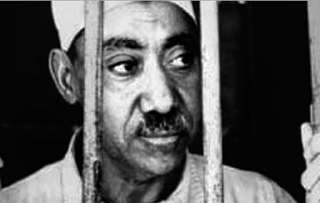
Succinct analysis of the roots of antisemitism by Brendan Sims and Charlie Laderman, all the more remarkable for appearing in the left-leaning New Statesman. Here is the extract from The Longest Hatred about anti-Semitism in the Middle East (with thanks: Lily):
Sayid Qutb(top) and Ayatollah Khomeini : revolutionary anti-Semites
Previously, the Muslim-Jewish relationship was an ambiguous one. Although the Quran contains declarations commanding all Muslim believers to kill Jews and Christians, there are also verses urging tolerance towards both. There were pogroms against Jews in Granada (1066) and Fez (1465) in which thousands were killed. Within the Ottoman empire, however, Jews enjoyed protection as second-class citizens, allowed to practise their religion quietly as long as they paid a special poll tax, abided by various proscriptions, including bans on bearing arms and riding horses, and accepted their inferior status.
Up until the 18th century, Jews fared far better in the Muslim world than in Christian Europe. When anti-Jewish persecution grew more pronounced in the 19th century, responsibility often lay with Christian Arab communities, whose propagation of the European-sponsored blood libel produced the Damascus outrage of 1840 in which 13 leading Jews were arrested and four killed.
It was only after the First World War, the Balfour Declaration and the establishment of European protectorates over parts of the former Ottoman empire that growing anti-Zionism provoked violence against Jews across the Arab world. Massacres of Jews occurred in Hebron (1929), Baghdad (1941) and Tripoli (1945).
The Grand Mufti of Jerusalem, who resided in Germany for much of the Second World War, urged the Nazis and their allies not to allow Jews to escape to Palestine, but to send them “to Poland” (meaning Auschwitz) instead. Even before the establishment of Israel in 1948, therefore, paranoid, political anti-Semitism had gained a foothold in the Islamic world.
After 1948, anti-Semitism among Arabs was exacerbated by the defeat of their armies by a people traditionally confined to a subservient position in the Muslim world. A tragic consequence of the war was that hundreds of thousands of Palestinian Arabs fled or were expelled and, in response, hundreds of thousands of Jews from across the Arab world, members of 2,000-year-old communities, were now identified as Zionist agents, persecuted and ultimately driven to seek refuge in Israel.
The Protocols, which first appeared in Arabic in 1927, and Hitler’s Mein Kampf, partially published in Arabic in the 1930s and fully in 1963, now found even more enthusiastic readers across the region. As the USSR emerged as a political ally of the Arab nations, and the United States forged closer ties with Israel after the 1967 war, Arab anti-Semites increasingly focused on the allegedly capitalist and imperialist character of world Jewry, and on Jewish control over US foreign policy.
In recent decades, this brand of anti-Semitism has become increasingly Islamised. As early as 1950, the seminal Islamist thinker and Muslim Brotherhood leader Sayyid Qutb was writing about “Our Struggle With the Jews”. Qutb claimed that “world Jewry’s purpose is to eliminate all limitations, especially the limitations posed by faith and religion, so that the Jews may penetrate into [the] body politic of the whole world and then may be free to perpetuate their evil designs”.
But it was only with the failure of Arab nationalism by the late 1970s that Islamist anti-Semitism really took off.
The founding charter of Hamas, the Sunni Muslim fundamentalist organisation that governs Gaza, refers approvingly to the Protocols and quotes a Quranic verse that states: “The hour of judgment shall not come until the Muslims fight the Jews and kill them, so that the Jews hide behind trees and stones, and each tree and stone will say: ‘O Muslim, o servant of Allah, there is a Jew behind me, come and kill him.’
The leader of the 1979 Iranian Revolution, Ayatollah Khomeini, declared in his Islamic Government (1970) that “Jews and their foreign backers are opposed to the very foundations of Islam and wish to establish Jewish domination throughout the world”. Khomeini’s successor, Ayatollah Khamenei, often denies the Holocaust, and he and other Iranian leaders routinely refer to the global dominance of “Jewish” and “Zionist” forces – terms that they use interchangeably.
Iran’s Shia proxy, Hezbollah, has fought to keep Anne Frank’s diary out of Lebanese schools as part of a Holocaust denial campaign and its leader, Hasan Nasrallah, stated that if the Jews “all gather in Israel, it will save us the trouble of going after them worldwide”. However, this did not preclude Hezbollah from targeting a Jewish community centre in Buenos Aires (1994) or bombing Israelis on a bus in Bulgaria (2012).
Even in Malaysia, remote from Israel and home to barely any Jews, anti-Semitism is rife. In 2003 Prime Minister Mahathir Mohamad urged the world’s Muslims to unite against Jews, claiming that although Europeans had killed six million of them, “today the Jews rule the world by proxy”.
Just last month, Dr Fouad Bseiso, the Palestine Monetary Authority’s first governor in the 1990s, claimed on Hamas satellite TV that “global Judaism” had caused the 2008 financial crisis, fulfilling plans revealed in the Protocols. Explicit anti-Semitism is routine in Middle Eastern political discourse. At the same time, this toxic ideology is being reimported into its continent of origin and is now flourishing among disenfranchised Muslim immigrant communities in Europe.


Leave a Reply